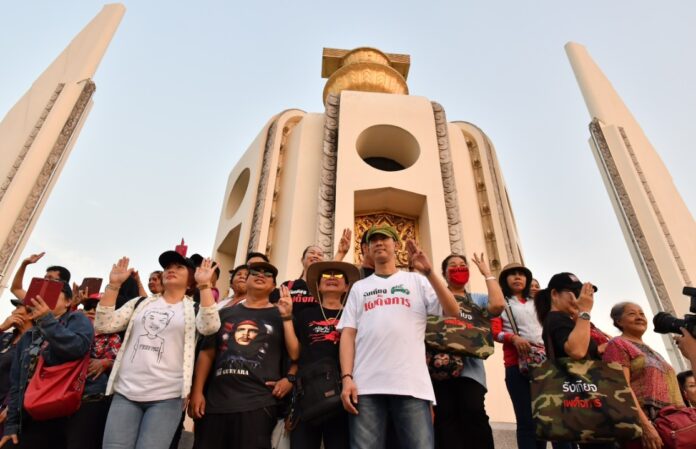
BANGKOK — Works are underway to tear down buildings along a 1,200-meter stretch of the iconic Ratchadamnoen Avenue and rebuild them under a new architectural style per orders from the Crown Property Bureau, who owns the land.
According to its website, the bureau – which manages assets and properties on behalf of His Majesty the King – pledged to renovate 10 buildings on the avenue in a “neoclassical” style, ditching the art deco look originally implemented in the spirit of a 1932 revolution that overthrew the absolute monarchy.
The announcement, which promises to be the biggest alteration to the Ratchadamnoen Avenue since 1940, drew praises from some who believe the redo would attract more businesses and tourists, while a historian expressed unease at that memories attached to the democratic revolution would be erased along with the avenue’s old look.
Read: Could Democracy Monument Be Razed? It’s Been Tried Before.
“I think what the Crown Property Bureau is doing is good. It will make the area artistic for visitors or tourists,” Sakchai Sakdarat , a Vice President at Deves Insurance, whose office will undergo the renovation. “The style is okay. Neoclassical is beautiful and it will become an artistic tourist spot.”
Deves Insurance’s flagship building on Ratchadamnoen is currently a six-storey art deco structure. Sakchai said the Crown Property Bureau informed his company and other tenants about the façade renovation at a meeting in February 2019.
“It will be for the whole avenue,” said Sakchai, who attended that meeting in person. He also said the tenants were told His Majesty the King has seen and approved the plan.
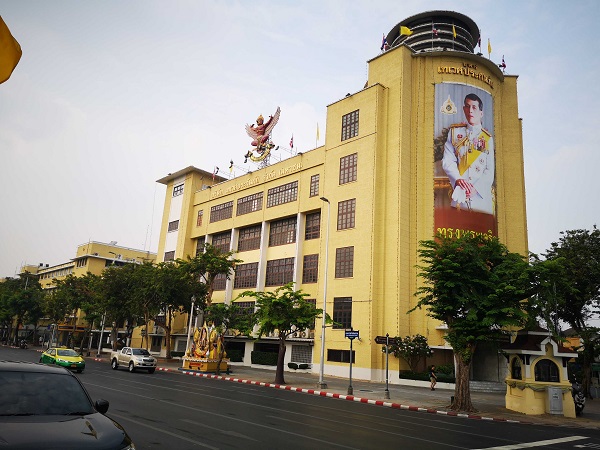
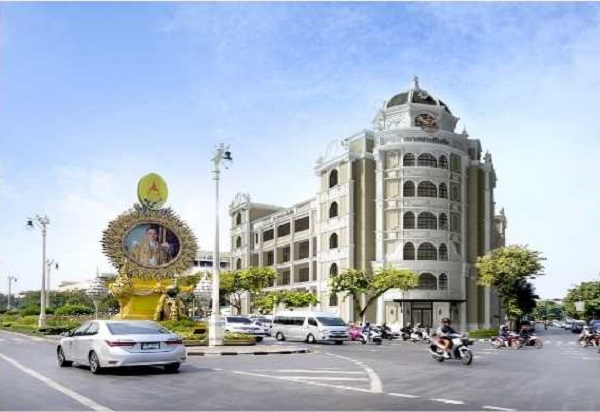
The Crown Property offered more information about the neoclassical push on Friday, when it announced on its website that the new look will showcase “art, culture, and identity of Thailand.” The renovation is designed to reflect architectural style that marked the eras of King Rama V and King Rama VI, the website said.
The announcement added that the renovation will start at the Deves Insurance head office and the Rattanakosin Exhibition Hall, which is operated by the Crown Property.
But it appears that work has already begun at another site. A kilometer down the avenue, scaffoldings covered a four-storey building where a sign posted by its tenant, the Government Savings Bank, said a 123-million baht “renovation” is ongoing.
Construction at the building, which is located at Kok Wua Intersection close to the backpacker street of Khaosan, will be completed in September, the sign reads.
Two Sides of History
Ratchadamnoen Avenue is perhaps the most politically charged landmark in the capital; its history symbolizing the ebb and flow of the ideological struggles that define the last century of Thai politics.
Construction first began in 1899, ordered by King Rama V who wished to imitate the modern, grand avenues that he witnessed during his European tour. Historians said the avenue also doubles as a projection of power by the the king’s absolute monarchy regime.
Though each end of the avenue stood two spectacular palaces, much of the road was home to empty lots and trees, until a revolution in 1932 overthrew the king’s direct rule and replaced it with a parliamentary democracy.
The revolutionaries, who called themselves the People’s Party, soon set out to fill Ratchadamnoen Avenue with buildings designed under art deco style, said architectural historian Chatri Prakitnonthakan. He said art deco was chosen by the revolutionaries to signify a break with the feudal past.
“Buildings with this look came to represent democracy. It represents the ushering of the modern era,” Chatri said. “It’s democratic architecture.”
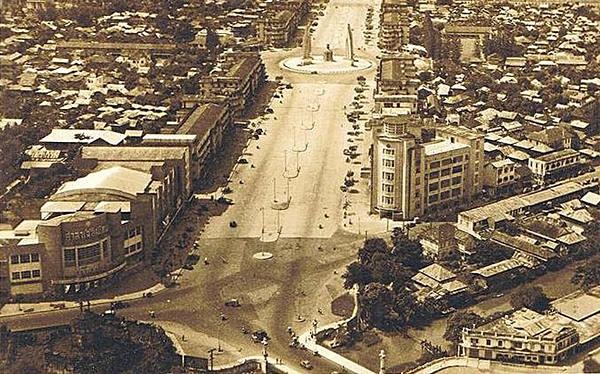
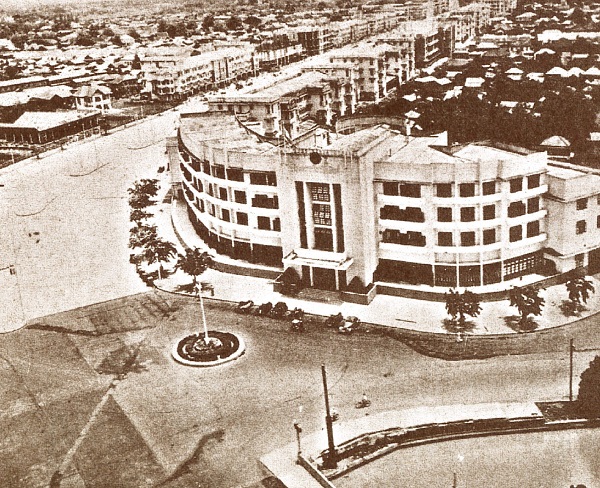
Their project was formally inaugurated in 1940, including the Democracy Monument that was placed right in the middle of the avenue. But despite their historical and cultural significance, they are not considered “protected buildings” under the law, and therefore subject to any plan of demolition or renovation – such as the one happening right now.
Chatri feared the renovation might have a darker intention of obliterating the architectural memories of the 1932 revolution.
“The conservatives are not happy and hate this type of buildings,” Chatri said, noting that similar relics to the revolution have been removed in recent years, like the Defense of the Constitution Monument in Laksi.
Artist Sinsawat Yodbangtoey, whose paintings often pay tribute to the 1932 revolution, also said he disagreed with the plan.
“I strongly disagree with it,” Sinsawat said. “The art deco buildings on Ratchadamnoen Avenue are a legacy of a revolt which ended absolute monarchy. The buildings symbolize a change of thinking towards something new.”
Questions Remain
Chatri added that he’s baffled by the Crown Property Bureau’s attempt to tie the neoclassical style to Ratchadamnoen’s history, since the style was never implemented on the avenue in the first place; both sides of the road were lined with mahogany trees under King Rama V.
“I think many people do not feel good about how it will look because it’s very fake,” the scholar said. “It’s wrong, both historically and aesthetically.”
In spite of the magnitude of the change coming to one of the most iconic landmarks in the Old City, few people are willing to discuss the issue.

The Crown Property Bureau listed an official named Thana Kachaprai as the head of its renovation project. Thana was not available for an interview despite repeated attempts to seek his comments.
The Bangkok administration’s City Public Works Department, which oversees building codes and construction regulations in the capital, distanced itself from the project.
“It has nothing to do with us. It’s the property of the Crown Property Bureau,” department director Thaiwuth Khankaew said on the phone.
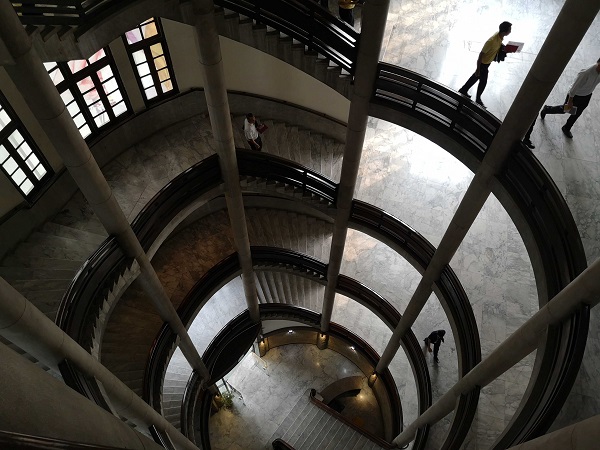
Many workers and tenants whom Khaosod English interviewed in the areas also asked not to be identified, though they said they carry out whatever changes or construction as instructed by the Crown Property Bureau.
Sakchai from Deves Insurance said tenants were told by the Crown Property they are free to hire architect firms and design the new neoclassical façade on their own, but they must seek approval from the bureau before executing the plan.
It’s unclear who will shoulder the cost of the makeover. Following a legal amendment in 2017, which ended any oversight from the Ministry of Finance, the Crown Property Bureau is directly under supervision of the royal palace.
Correction: An earlier version of this article incorrectly stated that Rattanakosin Exhibition Hall is operated by Bangkok Bank. In fact, it is under the management of the Crown Property Bureau.
Related stories:















































